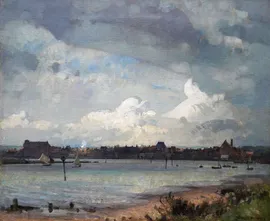John Alfred Arnesby Brown (1866-1955)
Sir John Alfred Arnesby Brown RA (1866-1955) was an English landscape artist and one of the leading British landscape artists of the 20th century and best known for his impressionistic depictions of pastoral landscapes, often featuring cattle. Arnesby Brown first studied at the Nottingham School of Art in the late 1880s, before entering the studio of Andrew McCallum where he first started to paint outdoors. This was followed by a move to London where he became a pupil of Hubert von Herkomer, and was influenced by Barbizon and Impressionist landscape painters. He later studied at the Bushey School of Art in Hertfordshire for four years from 1889. Brown spent much of his life at St Ives, Cornwall, between 1890 and 1910, where he came to paint 'en plein air' with artists such as Stanhope Forbes and Adrian Stokes. He was highly respected in Cornwall and was elected President of St Ives Society of Artists. Sir John Arnesby Brown ranks alongside the top British Impressionists. Three of his paintings were purchased for the nation by the Chantrey Bequest, at a time when it was considered as an 'unprecedented compliment' for an artist to have two works thus selected. After exhibiting at the Royal Academy for the first time in 1890, he became an elected Associate there in 1903. In 1896 he married Mia Edwards (1870–1931), a painter who studied at Bushey under Sir Hubert von Herkomer. They lived in Norfolk and St Ives, Cornwall. Arnesby Brown was knighted in 1938. He died in 1955, having not painted since 1942 due to blindness. He is buried in the cemetery of the Parish Church of St Mary in his hometown of Haddiscoe, Norfolk. His brother Eric Brown (1877–1939) was the first director of the National Gallery of Canada, from 1912 till 1939.

